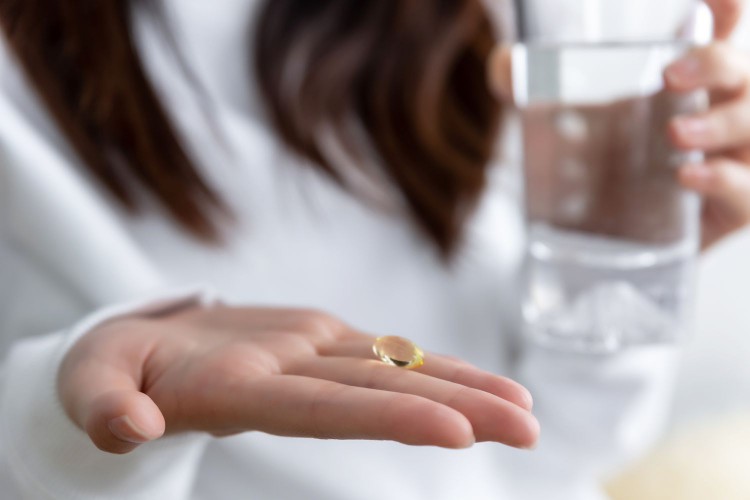Current vitamin D dosage recommendations may not be high enough, according to new research.
Two new studies from Intermountain Health, presented at the American Heart Association’s 2023 Scientific Sessions, focused on vitamin D’s effects on heart disease and stroke. In doing so, they found that the current dosage recommendations for the micronutrient may be too low.
Insufficient amounts of vitamin D can lead to serious health consequences.
“We have previously evaluated vitamin D in observational studies and found insufficient levels to be associated with adverse cardiovascular outcomes,” lead study author Heidi May, PhD, told Health.
May explained that other observational studies have reported similar findings, so the research team wanted to evaluate the association in a randomized clinical trial.
The current daily recommendation for vitamin D is 600 International Units (IU) for adults aged 19–70, and 800 IU for adults 71 and older.
Here’s why the current vitamin D dosage recommendation may not be enough, how too little vitamin D can negatively impact your cardiovascular health, and how to ensure you’re getting enough vitamin D.

Getty Images / Istockexstock
There are a few ways someone can take in vitamin D.
Known as “the sunshine vitamin,” solar rays are the primary source of vitamin D. The nutrient is also found in some foods like fortified milk, orange juice, fatty fish, and beef liver.
Enough vitamin D can provide multiple health benefits, including:
One of the lesser-known effects of vitamin D is its positive impact on the cardiovascular system. This is likely due to its anti-inflammatory action.
“Vitamin D supports heart health by regulating blood pressure, reducing inflammation, and improving function of blood vessels, promoting better blood flow,” Veronica Rouse, RD, CDE, of The Heart Dietitian, told Health.
According to May, multiple previous studies have established these benefits.
Knowing that vitamin D could impact heart health, the research team set out to determine whether current dosing recommendations are helping people achieve optimal levels.
In the first of the two studies, 632 patients were enrolled in a randomized clinical trial and divided into two groups. One group received targeted, personalized vitamin D treatment, while the other simply received a general recommendation to talk to their doctor about vitamin D supplementation.
Those in the targeted treatment group received vitamin D supplements as needed to help them achieve blood levels of over 40 nanograms per milliliter (ng/ml), identified as a baseline optimal level for cardiovascular disease prevention.
Those in the doctor discussion group received no specific amount of supplementation.
Remarkably, 86.5% of subjects in the as-needed dosing group required more than 2,000 IU of daily vitamin D to achieve a 40 ng/ml blood level, and 14.6% required over 10,000 IU daily.
Reaching these levels wasn’t a quick process. Less than 65% of subjects got to the 40 ng/ml mark in three months, and 25% needed at least six months to get there.
To measure the impact of these findings on heart health, the research team conducted an additional analysis.
This time, they identified subjects who had a cardiovascular event within 30 days of enrollment in the study. In these people, baseline vitamin D levels were a median of 25 ng/ml, significantly below the optimal 40 ng/ml level.
May explained that her main takeaway from these studies is that ideal vitamin D intake (especially for heart health) may need to be targeted to individuals, rather than based on a blanket daily recommendation.
“Prior vitamin D supplementation studies gave everyone the same dose of vitamin D, regardless of their blood level,” she said. “This study will be the first to show whether it is important for a patient to obtain a certain blood level of vitamin D to reduce their risk of having an adverse cardiovascular event.”
Since people’s vitamin D needs can vary, it might be tricky to understand how much you personally need, and whether or not you’re getting that amount from food and sunshine alone.
Having your levels tested regularly can give you a sense of whether your intake is sufficient.
“Testing vitamin D levels in the blood and speaking with a healthcare provider will be the best way to determine how much vitamin D you should take, especially when considering higher doses,” Rouse said.
Certain health conditions may also increase your needs.
People with difficulty absorbing nutrients due to inflammatory bowel disease, celiac disease, cystic fibrosis, or bariatric surgery may need to supplement with extra vitamin D.
If you’d like to add a supplement, talk to your doctor about how many IUs are too many. Higher doses than the recommended 600-800 IU per day can be safe—but only up to a point.
According to the National Institutes of Health, ingesting too much vitamin D could result in adverse side effects like nausea, vomiting, poor appetite, dehydration, and kidney stones.
Besides adding a supplement to your routine, you can always boost your vitamin D levels with dietary choices.
“To achieve optimal Vitamin D levels, dietary sources like fatty fish, egg yolks, and fortified foods are key,” Rouse said.
Both vitamin D-fortified milk and orange juice, for example, contain just under 100 IU per cup. Or, for an even greater boost, try cod liver oil; it contains 1,360 IU of vitamin D per tablespoon.
Spending time in the sun is another simple way to increase your body’s natural production of this vitamin.
Try an outdoor walk around midday when the sun’s UVB rays are the most intense. Expose more of your skin to allow for greater absorption. With the right combination of time in the sun, high-vitamin D foods, and supplementation, you’ll optimize your levels for heart health and other benefits.